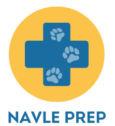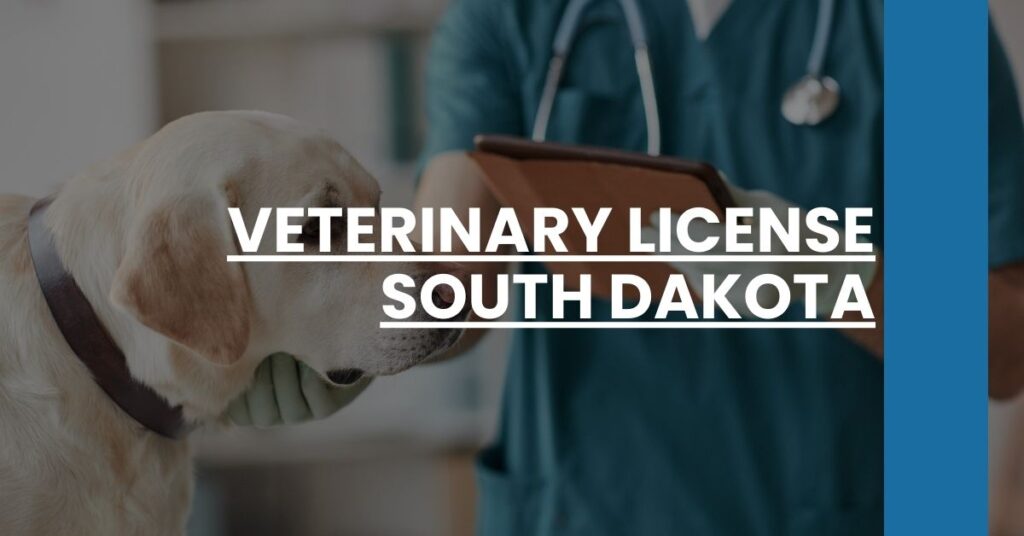Looking for schools in a specific city? Check out our lists of Veterinarian Schools in Sioux Falls and Rapid City.
Obtaining your Veterinary License in South Dakota might feel like a daunting task. Trust me, I get it. Navigating through educational requirements, exams, and the state’s specific procedures can be overwhelming. Our team has put together a comprehensive guide to make the process clearer and more manageable:
- Understand the prerequisites for a Veterinary License South Dakota, including essential educational qualifications and necessary exams.
- Learn about the mandatory North American Veterinary Licensing Exam (NAVLE) and any additional state-specific tests.
- Follow a detailed, step-by-step application guide from document submission to the final approval to streamline your journey.
We’ll help you through each step to simplify this complex process.
- Understanding Veterinary Licensing Requirements in South Dakota
- Steps to Apply for a Veterinary License in South Dakota
- Continuing Education for Licensed Veterinarians
- Veterinary Technician Licensure in South Dakota
- Frequently Asked Questions About Veterinary Licensing
- Resources and Contacts for Veterinary Licensing
- How to Become a Veterinarian
- Looking for Veterinarian Information On States Bordering South Dakota?
- Conclusion
Understanding Veterinary Licensing Requirements in South Dakota
The process for obtaining a veterinary license in South Dakota involves several critical steps. You’ll need to meet certain educational requirements, pass relevant exams, and submit a detailed application to the state board. To help you navigate this process, let’s break down these requirements.
Educational Qualifications
To qualify for a veterinary license in South Dakota, you must have a degree from an accredited veterinary program. According to the South Dakota Veterinary Medical Examining Board (SDVMEB), the following are required:
- Graduation from an Accredited Program: You must have a Doctor of Veterinary Medicine (DVM) degree from a college accredited by the American Veterinary Medical Association (AVMA).
- Foreign Graduates: If you attended a non-accredited foreign school, you must obtain certification through the AVMA’s Educational Commission for Foreign Veterinary Graduates (ECFVG) or the Program for the Assessment of Veterinary Education Equivalence (PAVE) by the American Association of Veterinary State Boards (AAVSB).
- Verification of Graduation: You need a signature from the Dean of your veterinary college and a copy of your diploma to verify your education.
Exam Requirements
After completing the educational prerequisites, you’ll need to pass several examinations. These exams assess your knowledge and competency in veterinary medicine.
- North American Veterinary Licensing Examination (NAVLE): This is a fundamental requirement for licensure. The NAVLE is a computer-based test that evaluates your ability to practice veterinary medicine in a comprehensive manner.
- Preparation: To get a head start, consider taking a NAVLE practice test.
- South Dakota Jurisprudence Exam: In addition to the NAVLE, you must pass a state-specific jurisprudence exam. This test ensures that you understand South Dakota’s veterinary laws and regulations. The minimum passing score for this exam is typically 90.
Age and Moral Character
South Dakota law states that applicants must be over the age of 18 and demonstrate good moral character. This requirement helps ensure that only individuals who are responsible and ethical are granted a license to practice.
Steps to Apply for a Veterinary License in South Dakota
Applying for your veterinary license involves several essential steps. Follow this guide to ensure a smooth and successful application process.
Gather Required Documents
Before starting your application, make sure you have all necessary documents:
- Proof of Education: Include your DVM degree and verification from your college dean.
- Exam Scores: Provide your NAVLE score and state jurisprudence exam results.
- Proof of Good Standing: If you’re licensed in another state, you must show that your license is in good standing.
Complete the Application
- Official Application: The SDVMEB provides an official licensing application form. Download and complete this form carefully.
- Application Fee: Pay the non-refundable application fee of $75.
- License Fee: The biannual license fee for South Dakota is $100 for odd-numbered years and $50 for even-numbered years.
Submit Your Application
After gathering your documents and completing the application, submit your application along with the fees to the SDVMEB. Ensure your application is thorough and accurate to avoid delays.
Continuing Education for Licensed Veterinarians
Once you receive your license, maintaining it through Continuing Education (CE) is essential. South Dakota places high importance on CE to ensure that veterinarians stay updated with the latest advancements in veterinary medicine.
CE Requirements
- 32 Hours Every 2 Years: South Dakota mandates 32 hours of CE every two years. These hours keep your knowledge current and ensure you’re equipped to provide the best possible care to your patients.
- Accepted Formats: Online courses are accepted, providing flexibility in how you complete your CE hours.
Renewal Process
To renew your license, you must submit proof of your CE hours along with the renewal application. The SDVMEB outlines specific policies and accepted courses for CE, ensuring that you have clear guidance on how to meet these requirements.
Leveraging these resources not only keeps you compliant but also enhances your competencies, ultimately benefiting your practice and your patients.
If you’re interested in a more detailed understanding of continuing education requirements, you can visit the South Dakota Veterinary Medical Examining Board’s CE policies on their official website.
As you continue your journey in veterinary medicine, keep in mind that ongoing education and adherence to regulatory standards are cornerstones of a successful and reputable practice.
Veterinary Technician Licensure in South Dakota
Introduction to Veterinary Technicians
You might be interested in becoming a veterinary technician rather than a veterinarian. Understanding the path to licensure for veterinary technicians in South Dakota can help guide your career in veterinary medicine. Veterinary technicians (RVTs) play an instrumental role in assisting veterinarians in providing quality care for animals.
Educational Requirements
To become a licensed veterinary technician in South Dakota, you must first graduate from an accredited veterinary technician program. Here’s what you need to know:
- Accredited Program: Your veterinary technician program must be accredited by the American Veterinary Medical Association (AVMA).
- Completion Certification: You must obtain a certificate or associate degree in veterinary technology upon graduation.
Examination Requirements
After completing the educational program, you’ll need to pass the Veterinary Technician National Examination (VTNE). Here’s a closer look at the specifics:
- VTNE Overview: The VTNE is designed to assess your capabilities in various areas such as animal nursing, pharmacology, surgical preparation, and laboratory procedures.
- Passing Score: Ensure that you meet or exceed the minimum passing score to qualify for licensure.
Application Process
After fulfilling the educational and examination requirements, your next step is to apply for licensure:
- Complete the Application: Download and fill out the official application form provided by the South Dakota Veterinary Medical Examining Board (SDVMEB).
- Proof of Education: Submit your degree and any related certifications.
- Exam Scores: Include your VTNE score report.
- Application Fee: Pay the required application fee as determined by the SDVMEB.
Upon successful completion of these steps, you will receive your license to practice as a veterinary technician in South Dakota.
Frequently Asked Questions About Veterinary Licensing
You might have several questions about obtaining a veterinary license in South Dakota. Below are some of the most common inquiries and their answers.
How Long Does the Application Process Take?
The time frame for processing your veterinary license application can vary. On average, it may take several weeks from the submission of a complete application to receive your license.
Can I Transfer My License from Another State?
If you’re already licensed in another state and wish to practice in South Dakota, you’re in luck. You can apply for licensure by endorsement, which involves proving that your current license is in good standing and meeting any state-specific requirements.
What Is the State Jurisprudence Exam?
The state jurisprudence exam is vital since it assesses your understanding of South Dakota’s veterinary laws and regulations. Make sure you study state-specific guidelines to pass this test successfully.
Is There a Fee for License Renewal?
Yes, you must pay a fee when renewing your veterinary license. Ensure you complete the renewal form and submit it with the appropriate payment before the deadline.
What If I Don’t Meet the Continuing Education Requirements?
Failing to meet the Continuing Education (CE) requirements could result in penalties, including suspension of your license. Always ensure that you complete the required CE hours before your renewal period to avoid any complications.
Resources and Contacts for Veterinary Licensing
Having access to the right resources can make your journey to obtaining and maintaining a veterinary license much more manageable. Below are some useful resources and contact information:
- South Dakota Veterinary Medical Examining Board (SDVMEB): They oversee licensure, examinations, and continuing education requirements.
- Contact Information: 411 S. Fort St., Pierre, SD 57501, Phone: 605-773-3321, Email: [email protected].
- American Veterinary Medical Association (AVMA): This body accredits veterinary programs and offers valuable resources for veterinary professionals.
- American Association of Veterinary State Boards (AAVSB): They administer examinations like the NAVLE and PAVE, and provide additional resources.
Leveraging these resources can help ensure you’re following the correct procedures and staying up to date with industry standards.
How to Become a Veterinarian
Choosing to become a veterinarian involves more than just obtaining a license. Here’s what you need to know about the pathway to this rewarding career.
Educational Requirements
First, aspiring veterinarians need a Doctor of Veterinary Medicine (DVM) degree. Here’s the typical educational path:
- Undergraduate Degree: Obtain a bachelor’s degree with a pre-veterinary focus, including courses in biology, chemistry, and animal science.
- Veterinary School: Attend an AVMA-accredited veterinary school to complete your DVM degree.
Clinical Rotations and Internships
During veterinary school, you’ll participate in clinical rotations and internships. These hands-on experiences are crucial in developing your practical skills and understanding of animal care.
Licensure Examinations
After graduation, you must pass the NAVLE and any state-specific exams to receive your license. Detailed information can be found in the steps outlined above.
Continuing Education and Specializations
Continuing education is crucial for maintaining your license. Additionally, you can pursue specializations in areas like surgery, internal medicine, or exotic animal care to expand your expertise and career opportunities.
For an in-depth guide on this process, visit how to become a veterinarian.
Looking for Veterinarian Information On States Bordering South Dakota?
In addition to South Dakota, we suggest looking for schools in nearby states.
- Veterinary License North Dakota
- Veterinary License Minnesota
- Veterinary License Iowa
- Veterinary License Nebraska
- Veterinary License Wyoming
Conclusion
By understanding the specific steps and requirements for obtaining a veterinary license in South Dakota, you can effectively navigate the process and pursue your career in veterinary medicine. Whether you’re aiming to become a veterinarian or a veterinary technician, thorough preparation and adherence to the state’s guidelines are key to success.

